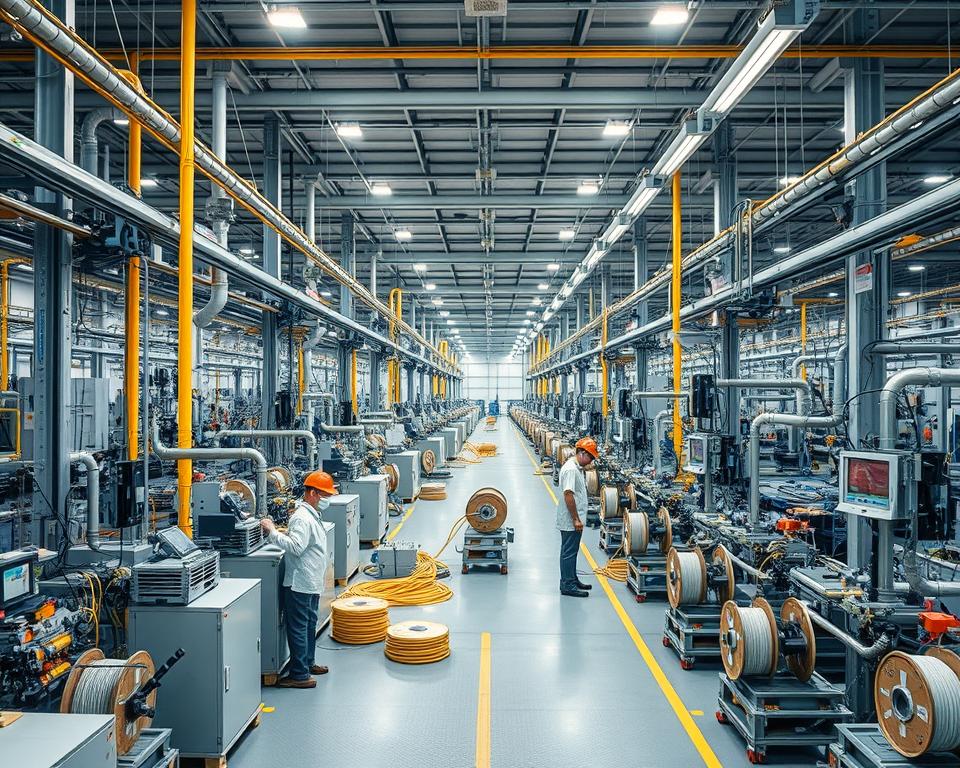Your Comprehensive Resource for FTTH cable Production Line
This is your comprehensive resource for understanding the FTTH cable production line. This comprehensive article will explore the realm of fiber optic cables and their vital function in facilitating high-speed data transmission. The continuous growth in demand for faster and more reliable internet connectivity makes it essential to understand the details of FTTH cable production. Covering the essentials of cable infrastructure to the detailed manufacturing process, this guide aims to provide you with valuable insights into the production of compact fiber unit.
Whether you are new to the industry or looking to enhance your knowledge, this guide has you covered. This guide will delve into the essential components of FTTH cable systems, the function of optical fibers in FTTH technology, and how raw materials are turned into top-quality fiber optic cables. The guide will also touch upon design considerations, stranding techniques, buffering and jacketing processes, and the efficient functioning of the FTTH cable production line.
Look out for information on the advanced technologies that are changing FTTH cable manufacturing, as well as the vital role of testing and quality assurance in guaranteeing the reliability and durability of fiber optic cables. We will also cover the final steps of packaging and distribution, ensuring that the FTTH cable production line operates seamlessly from start to finish.
Important Aspects:
- High-speed data transmission relies heavily on the FTTH cable production line.
- Understanding the basics of FTTH cable infrastructure and key components is crucial.
- The FTTH cable production process, which goes from silica to fiber, involves fiber drawing, coating application, and testing.
- Designing configurations and layouts that meet specific network requirements can optimize performance.
- The fiber gains support and protection from stranding techniques and central strength members.
Fundamentals of FTTH cable Production
A clear understanding of the cable infrastructure, key components, and the role of optical fibers in FTTH technology is essential to comprehend the FTTH cable production process.
Getting to Know the FTTH cable Infrastructure
The network of cables, connectors, and distribution points that facilitates data transmission in fiber-to-the-home (FTTH) systems is known as the FTTH cable infrastructure. The backbone of high-speed internet connectivity is formed by this infrastructure, which allows for seamless data transfer between the provider’s network and the end user’s location.

Main Parts of FTTH cable Systems
To ensure data transmission is smooth and efficient, FTTH cable systems rely on several key components working in unison. These components include:
- Fiber optic cables: These cables are responsible for carrying the data signals in the form of light. Designed to offer high bandwidth and minimize signal loss, they ensure data transmission is fast and reliable.
- Joining fiber optic cables to other cables or devices is a crucial role of connectors, which also facilitate connection and disconnection when needed. A secure and reliable connection is provided by them, which helps minimize signal loss.
- Fiber optic signals are divided and distributed to multiple end users using distribution points. Without negatively impacting the overall network performance, they help ensure each user receives the necessary bandwidth.
Significance of Optical Fibers in FTTH Technology
Without optical fibers, FTTH technology wouldn’t be possible. Designed to efficiently transmit data signals as light pulses, these thin strands are made of glass or plastic. Because of their high bandwidth capacity, low signal loss, and immunity to electromagnetic interference, optical fibers are perfect for high-speed data transmission.
The fibers are made of a core, which carries the light signals, surrounded by a cladding layer that reflects the light back into the core, preventing signal loss. Because of this design, optical fibers can transmit data across great distances without any loss in signal quality or speed.
How FTTH cable is Made: From Silica to Fiber
The Art of Fiber Drawing: Creating the Cable’s Core
Fiber drawing is the initial step in the FTTH cable production process, and it’s where the cable’s core is made. Pulling and stretching a glass preform made of silica is how this process creates a long, thin fiber. Careful control of the fiber’s diameter during fiber drawing is essential for optimal performance. The cable’s ability to transmit data efficiently and accurately is largely determined by the quality and composition of the core.
How Coating Application Ensures the cable’s Durability
The process continues with coating application after the fiber has been drawn. This stage involves applying a protective layer, which is called a coating, to the fiber. Serving multiple functions, the coating acts as a buffer against external factors like moisture, which enhances the fiber’s long-term durability and reliability. Careful selection of the coating material ensures it has the right mechanical properties, which keeps the fiber intact and protected for its entire lifespan.
Quality Assurance: Fiber Testing at All Stages
Throughout the FTTH cable production process, fiber testing is conducted at various stages to verify the quality and performance of the fiber. The fiber’s physical parameters, including diameter, attenuation, and tensile strength, are measured during these tests, and the coating is also inspected for uniformity and adhesion. These tests are crucial for ensuring that the fiber meets the required standards and specifications, guaranteeing the overall quality and performance of the final FTTH cables.
| Production Stage | Testing Parameters |
|---|---|
| Fiber Drawing | Diameter, Attenuation, Tensile Strength |
| Coating Application | Coating Thickness, Uniformity, Adhesion |
Testing Parameters at Various Stages of FTTH cable Production: Table
The table above summarizes the testing parameters measured at different stages of the FTTH cable production process. The high-performance and reliability of FTTH cable systems are ultimately achieved because manufacturers conduct rigorous testing to ensure that every fiber used in the cables meets the required quality standards.
Design Considerations for FTTH cable Configurations
In the world of fiber-to-the-home (FTTH) cable production, the design of cable configurations plays a crucial role in meeting network requirements and optimizing performance. Considering network capacity, scalability, and the desired speed of data transmission is what cable design entails. Companies can make sure their network infrastructure is deployed efficiently and its capabilities are maximized by customizing cable configurations to meet specific needs.
When it comes to FTTH cables, there are many different configurations and layouts available, each with its own benefits and things to think about:
- Daisy Chain Configuration: In this configuration, each subscriber is connected sequentially to the main distribution point. It is a cost-effective solution suitable for areas with low subscriber density.
- A direct connection between each subscriber and the central office or hub is characteristic of the star configuration. This design provides flexibility and ease of maintenance, making it ideal for densely populated areas.
- Subscribers are connected in a circle in the ring configuration. If the network fails, it still provides service without interruption because it has redundancy and can tolerate faults.
- The main distribution point connects to secondary distribution points, and from there, individual subscribers are connected in a tree configuration. This configuration allows the network to grow easily and is often used in areas where there are a lot of subscribers.
- Distribution points have multiple connections between them in the mesh configuration, which provides high reliability and redundancy. It is commonly used in mission-critical applications where uninterrupted service is essential.
When you’re designing FTTH cable configurations, you need to take into account what the network needs and how much it’s likely to grow. The best configuration to choose depends on things like how many subscribers there are, where they are located, and what kind of service they need, as each configuration has its own advantages and disadvantages.
Companies can create FTTH cable configurations that are tailored to their specific network needs and provide the best performance by carefully considering these factors and working with experts in the field.
Understanding Stranding Techniques and Equipment
Stranding techniques and equipment are essential in the production of FTTH cables to guarantee their strength and durability. Different stranding patterns are employed, each with its own advantages and applications. The efficiency and quality of cable production depend on choosing the appropriate stranding machinery. In addition to stranding techniques, central strength members offer extra support and protection to the fiber, which helps make the FTTH cables more reliable overall.
A Look at Different Stranding Patterns
When producing FTTH cables, one of the main things to consider is which stranding pattern to use. Various stranding patterns, such as reverse concentric, SZ stranding, and helical stranding, are used depending on the desired characteristics of the cable. The unique features of each pattern can enhance the cable’s performance in areas like flexibility, strength, and how well it holds up against external factors. The specific needs of the application are met through the careful selection of stranding patterns, which guarantees optimal performance and a long life for the FTTH cables.
Selecting Appropriate Stranding Machinery
The FTTH cable production line relies heavily on stranding machinery. It allows for the accurate creation of the stranding pattern and ensures that the fibers are kept at the right tension and in the correct alignment. When selecting the right Fiber coloring machine machinery, you need to consider things like the cable’s diameter, the speed of production, and the level of automation you need. Because advanced stranding machines are more efficient and flexible, manufacturers can produce a large number of cables and also offer customization.
Role of Central Strength Members
To improve the mechanical properties of FTTH cables, central strength members are used. Stability is provided, tensile strength is improved, and the delicate fiber inside the cable is protected by them. Typically made of materials like aramid or fiberglass, the central strength members act as a backbone, reinforcing the cable structure and offering resistance against external forces. Because they are there, FTTH cables can handle the stresses of being installed and keep the signal transmission working properly, which makes them good for different ways of deploying them.
Fiber Protection: Buffering and Jacketing
During the production of FTTH cables, the buffering and jacketing processes are crucial for safeguarding the delicate fiber inside. These processes ensure that the fiber is shielded from an array of potential threats, including moisture, abrasion, and other external factors that could jeopardize its performance and longevity.
The Significance of Buffering in Fiber Protection
During the buffering process, a protective layer is applied to the fiber, and this layer serves as a barrier against environmental elements. This layer prevents water penetration, which can cause signal loss or even breakage of the fiber. Additionally, buffering enhances the cable’s resistance to abrasion, reducing the risk of damage during installation or maintenance.
The buffering materials used must exhibit excellent adhesion to the fiber and possess a low coefficient of friction to minimize stress on the fiber. The selection of the appropriate buffering material depends on factors such as the environmental conditions the cable will be subjected to and the desired level of protection.
Factors in Selecting Jacketing Materials
Applying an outer layer to provide even more protection for the fiber and the buffering materials is called jacketing. To offer robust protection from mechanical stress, impact, UV radiation, and other potential hazards, the jacketing material is carefully chosen.
The flexibility of the material, how well it resists flames, and whether it can withstand the environmental conditions are all factors considered when selecting jacketing materials. Materials such as polyethylene (PE), polyvinyl chloride (PVC), and low-smoke zero-halogen (LSZH) compounds are commonly used for jacketing. Because each material has its own advantages and disadvantages, the choice will depend on the specific application and what the industry standards are.
How Latest Jacketing Technologies are Applied
FTTH cables now have much better protection thanks to the advancements in jacketing technologies. You get better strength, more flexibility, and improved resistance to environmental factors with the latest technologies, which results in better durability and reliability.
Tight-buffered cables are one of the new jacketing technologies, and they involve buffering each fiber with a thin layer of plastic, which gives great protection and flexibility. Using strong tubing to hold multiple fibers is what micro-ducts do, and this technology offers high density and makes cable installation versatile.
In addition, there are special jacketing technologies that are made to meet the specific needs of different industries. As an example, cables that are used in tough outdoor environments might include armored jackets, which offer superior protection against rodents, moisture, and extreme temperatures.
By leveraging the latest jacketing technologies, FTTH cables can be customized to meet the demands of various applications, ensuring optimal performance, longevity, and reliability.
FTTH cable Production Line Operations
Efficient operations are key to ensuring a smooth and streamlined manufacturing process in the FTTH cable production line. The production of high-quality fiber optic cables for high-speed internet connectivity relies on each step in the production line being vital. The best efficiency is achieved through the use of various machinery and equipment.
The manufacturing process starts by getting the raw materials ready, such as the silica needed for fiber drawing. Then, the fiber drawing process commences, where the core of the cable is carefully crafted to achieve the desired specifications. Coating application is the next stage, and it ensures the fiber is durable and protected.
Ensuring the cables meet the highest standards is the top priority, so rigorous fiber testing is performed at every stage of the production line. Factors such as attenuation, bandwidth, and signal loss are all tested as part of this process.
Efficiency is a key factor in the operations of the FTTH cable production line. Manufacturers can reduce how long it takes to produce cables and how much it costs, while also making as many as possible, by using their machines and equipment in the best way. Additionally, efficient processes contribute to the overall quality of the cables.
The manufacturing process can be complex, involving various stages and components. If manufacturers focus on efficient operations and always look for ways to make things better, they can enhance how efficient and effective their FTTH cable production line is.
To help you fully understand how the FTTH cable production line works, here’s a table summarizing the key machinery and their roles in the manufacturing process:
| Machine | Role |
|---|---|
| Fiber Drawing Machine | Produces the fiber optic cable core by pulling and stretching the silica material. |
| Coating Machine | Applies a protective coating to the fiber optic cable, ensuring durability and resistance to external factors. |
| Fiber Testing Equipment | Conducts various tests on the fiber optic cable to ensure quality and performance. |
| Spooling Machine | Winds the finished fiber optic cable onto spools for packaging and distribution. |
| Jacketing Machine | Applies an outer jacket to the fiber optic cable, providing additional protection and improving its handling. |
Using advanced machinery and technologies allows manufacturers to make their production line operations more streamlined, enhance efficiency, and deliver high-quality FTTH cables that meet the rising demand for high-speed internet connectivity.
Advanced Technologies in FTTH cable Manufacturing
The field of FTTH (Fiber to the Home) cable manufacturing is constantly changing, and advanced technologies are crucial for making it more efficient and of higher quality. As the demand for high-speed data transmission rises, automation, the integration of AI, and fiber coloring machines have completely changed the production process, sparking innovation and leading to the delivery of superior products.
Automation in Fiber Optic cable Production
Automation has led to a major transformation in the manufacturing of fiber optic cables. With advanced machinery and robotics, the manufacturing process can be controlled with great precision, ensuring consistent quality and minimizing errors. Because of this automation, more cables can be produced faster and with better accuracy, which ultimately saves money and makes customers happier.
AI in Quality Control for cable Manufacturing
Using artificial intelligence (AI) in the quality control process allows FTTH cable manufacturers to reach new levels of accuracy and reliability. AI algorithms have the ability to analyze production data as it happens, identifying any changes or issues that could affect the quality of the cables. This proactive approach to quality control helps in minimizing errors, optimizing production efficiency, and ensuring that only the highest quality FTTH cables reach the market.
Fiber Coloring Machine Capabilities
Thanks to fiber coloring machines, FTTH cable manufacturing has been revolutionized, and now there are more ways to customize the cables. Optical fiber strands can be color-coded by fiber coloring machines, which makes it easy to identify them and manage the cables efficiently when installing or maintaining them. This technology eliminates the need for manual color coding, reduces the risk of errors, and improves the overall efficiency of cable deployment.
Testing and Quality Assurance: Key to Fiber Optic Reliability
It’s of the utmost importance to ensure the highest quality in the field of fiber optics. To make sure this happens, strict testing and quality assurance procedures are followed during the entire production process. The reliability and consistency of fiber optic cables are guaranteed by standardized testing protocols, which play a crucial role.
Steps to Implement Standardized Testing Protocols
The purpose of establishing standardized testing protocols is to ensure that every fiber optic cable meets the required quality standards. These protocols outline specific testing procedures and criteria that must be followed during each stage of the production process. By adhering to these protocols, manufacturers can identify and address any potential issues, ensuring that only the highest quality cables are delivered to customers.
How OTDR is Used for Quality Checks
Optical Time-Domain Reflectometer (OTDR) is an essential tool for checking the quality of fiber optic cables. OTDR is a testing instrument that sends light pulses to measure the amount of signal loss and reflection along an optical fiber. By analyzing the OTDR traces, technicians can detect issues such as fiber bending, signal loss, or connector damage. This allows them to identify the precise location of any faults and take corrective measures, guaranteeing the cable’s overall quality and performance.
How to Maintain High Quality Assurance Standards
To ensure fiber optic cables perform consistently and reliably, quality assurance standards are maintained throughout the entire production process. Material selection, how the cables are made, and testing of the final product are all covered by these standards. Manufacturers can guarantee that their products meet the highest quality and performance levels required by the industry by following these strict standards.
Packaging and Distribution: The Final Steps in FTTH cable Production
Packaging and distribution, the final steps in Fiber draw tower production, are what this section is about. Ensuring that the cables are packaged correctly and efficiently after they have gone through the various manufacturing processes is crucial for their deployment and installation in the field. Also, using protective packaging is very important for keeping the delicate fiber optic cables safe while they are being transported and stored. Efficient logistics and supply chain management are essential to ensuring that FTTH products are delivered to customers in a timely manner, meeting their connectivity needs effectively.
How to Spool cables Efficiently
Efficient cable spooling techniques are vital for the smooth and convenient installation of FTTH cables. Storing and transporting cables in an organized and practical way is possible with cable spools, which also reduces the chance of them getting tangled or damaged. Using optimized cable spooling techniques allows cable installers to save both time and effort during the deployment process. A neat and professional appearance of the installation is ensured by properly spooled cables, which also improve the overall aesthetics.
The Importance of Protective Packaging for Fiber Optic cables
Using effective protective packaging solutions is essential to keep the delicate fiber optic cables safe when they are being transported and stored. These solutions should provide cushioning, shock absorption, and resistance to external factors such as moisture, dust, and physical impact. Manufacturers can make sure the fiber optic cables arrive in perfect condition and ready to be installed by using high-quality packaging materials and techniques. This not only keeps the cables in good condition but also makes customers happier by reducing the chance of damage or the cables not working as well as they should.
How Logistics and Supply Chain Management Affect FTTH Products
It’s very important to have efficient logistics and supply chain management to successfully deliver FTTH products to customers. This includes making careful plans for how the cables will be transported, stored, and distributed to ensure they arrive when they should and are reliable. This helps to keep delays to a minimum and makes the flow of products better, which reduces costs and improves customer service, all thanks to effective supply chain management..
In Conclusion
In conclusion, the ultimate guide to FTTH cable production line has provided a comprehensive overview of the process involved in manufacturing fiber optic cables for high-speed internet connectivity. The importance of FTTH cable production line in enabling fast and reliable data transmission has been emphasized throughout the article.
Playing a critical role in high-speed internet connectivity, fiber optic cables allow for seamless communication, streaming, and online activities. Ensuring the durability and quality of these cables is the result of the step-by-step process of FTTH cable production, which includes fiber drawing, buffering, and jacketing.
Technologies like automation and AI integration, which are advanced, have completely changed the manufacturing process, leading to increased efficiency and accuracy. Standardized testing protocols and strict quality assurance standards also play a role in guaranteeing the reliability and performance of fiber optics.
FTTH cable production ends with packaging and distribution, which ensures these essential cables are deployed efficiently and kept safe during transportation. The increasing global demand for high-speed internet connectivity can only be met thanks to the expertise and precision involved in the FTTH cable production line.


